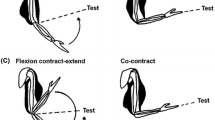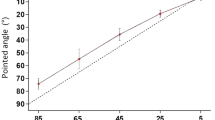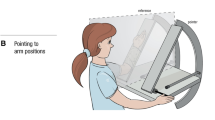Abstract.
Experiments were carried out to study the ability of human subjects to match the position of their forearms relative to the horizontal. The normal, arms-in-front position with the hands aligned and little forward flexion at the shoulder was called the reference position. When the arms were rotated to the side, one arm was raised, or both arms were raised, matching ability deteriorated compared with the reference position, when expressed as an increase in the standard deviation of matching errors. It was concluded that particular significance was assigned by the brain to the arms-in-front position, with the hands in their normal working space. Increases in errors were also observed when the reference arm was made weightless or its weight was increased by means of an adjustable load. This suggested that lifting the arm against gravity provided additional positional information. In a second experiment, dependence of the illusion of muscle lengthening evoked by vibration was tested after two different forms of muscle conditioning, a co-contraction of elbow muscles with the arm held flexed or with it held extended. The speed of the illusory extension of flexor muscles during their vibration increased three-fold after flexion conditioning compared with extension conditioning. Since after flexion conditioning, muscle spindles in flexor muscles are expected to be more sensitive to vibration than after extension conditioning, this observation provides additional support for the view that muscle spindles make an important contribution to kinaesthesia at the elbow joint.
Similar content being viewed by others
Author information
Authors and Affiliations
Additional information
Electronic Publication
Rights and permissions
About this article
Cite this article
Gooey, K., Bradfield, O., Talbot, J. et al. Effects of body orientation, load and vibration on sensing position and movement at the human elbow joint. Exp Brain Res 133, 340–348 (2000). https://doi.org/10.1007/s002210000380
Received:
Accepted:
Issue Date:
DOI: https://doi.org/10.1007/s002210000380




